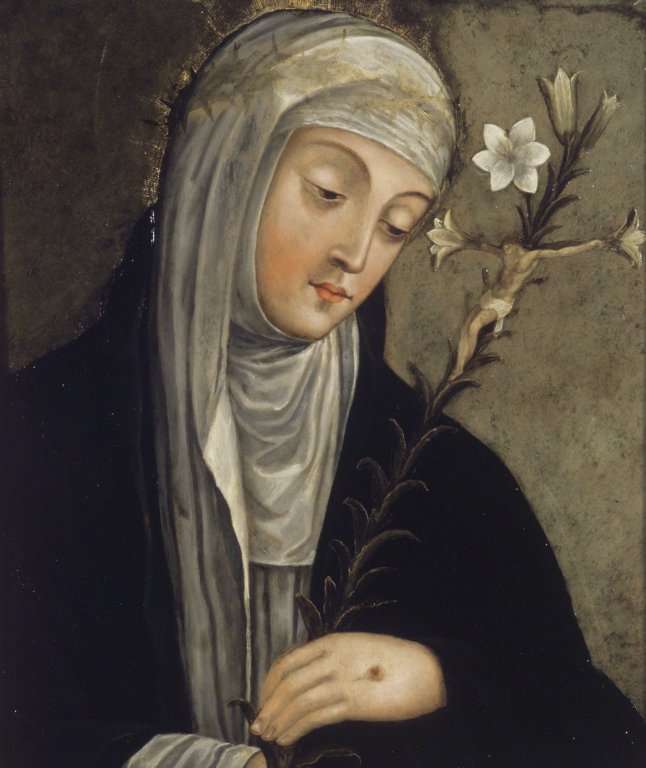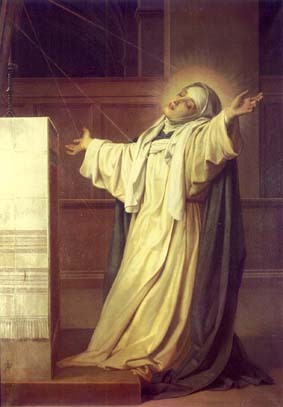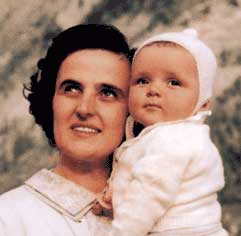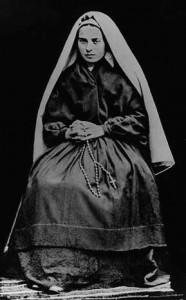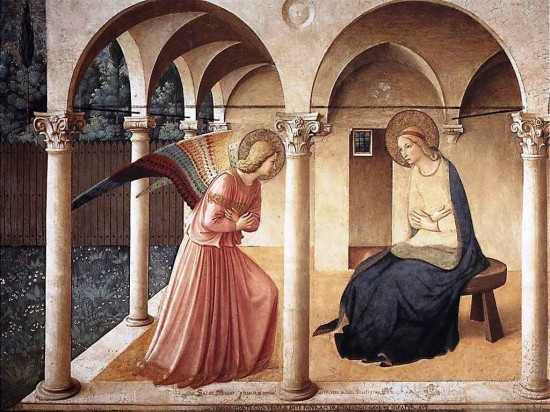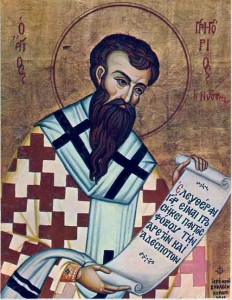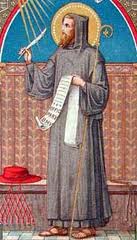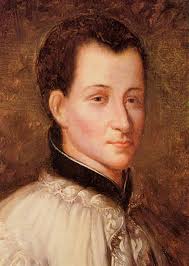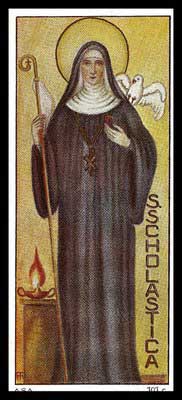Dominican Tertiary, born at Siena, 25 March, 1347; died at Rome, 29 April, 1380.
From the Catholic Encyclopedia, found at New Advent –
She was the youngest  one of a very large family. Her father, Giacomo di Benincasa, was a dyer; her mother, Lapa, the daughter of a local poet. They belonged to the lower middle-class faction of tradesmen and petty notaries, known as “the Party of the Twelve”, which between one revolution and another ruled the Republic of Siena from 1355 to 1368. From her earliest childhood Catherine began to see visions and to practise extreme austerities. At the age of seven she consecrated her virginity to Christ; in her sixteenth year she took the habit of the Dominican Tertiaries, and renewed the life of the anchorites of the desert in a little room in her father’s house. After three years of celestial visitations and familiar conversation with Christ, she underwent the mystical experience known as the “spiritual espousals”, probably during the carnival of 1366. She now rejoined her family, began to tend the sick, especially those afflicted with the most repulsive diseases, to serve the poor, and to labour for the conversion of sinners.Though always suffering terrible physical pain, living for long intervals on practically no food save the Blessed Sacrament, she was ever radiantly happy and full of practical wisdom no less than the highest spiritual insight. All her contemporaries bear witness to her extraordinary personal charm, which prevailed over the continual persecution to which she was subjected even by the friars of her own order and by her sisters in religion.
She began to gather disciples round her, both men and women, who formed a wonderful spiritual fellowship, united to her by the bonds of mystical love. During the summer of 1370 she received a series of special manifestations of Divine mysteries, which culminated in a prolonged trance, a kind of mystical death, in which she had a vision of Hell, Purgatory, and Heaven, and heard a Divine command to leave her cell and enter the public life of the world. She began to dispatch letters to men and women in every condition of life, entered into correspondence with the princes and republics of Italy, was consulted by the papal legates about the affairs of the Church, and set herself to heal the wounds of her native land by staying the fury of civil war and the ravages of faction. She implored the pope, Gregory XI, to leave Avignon, to reform the clergy and the administration of the Papal States, and ardently threw herself into his design for a crusade, in the hopes of uniting the powers of Christendom against the infidels, and restoring peace to Italy by delivering her from the wandering companies of mercenary soldiers. While at Pisa, on the fourth Sunday of Lent, 1375, she received the Stigmata, although, at her special prayer, the marks did not appear outwardly in her body while she lived.
Mainly through the misgovernment of the papal officials, war broke out between Florence and the Holy See, andalmost the whole of the Papal States rose in insurrection. Catherine had already been sent on a mission from the pope to secure the neutrality of Pisa and Lucca.
In June, 1376, she went to Avignon as ambassador of the Florentines, to make their peace; but, either through the bad faith of the republic or through a misunderstanding caused by the frequent changes in its government, she was unsuccessful. Nevertheless she made such a profound impression upon the mind of the pope, that, in spite of the opposition of the French king and almost the whole of the Sacred College, he returned to Rome (17 January, 1377).
Catherine spent the greater part of 1377 in effecting a wonderful spiritual revival in the country districts subject to the Republic of Siena, and it was at this time that she miraculously learned to write, though she still seems to have chiefly relied upon her secretaries for her correspondence. Early in 1378 she was sent by Pope Gregory to Florence, to make a fresh effort for peace. Unfortunately, through the factious conduct of her Florentine associates, she became involved in the internal politics of the city, and during a popular tumult (22 June) an attempt was made upon her life. She was bitterly disappointed at her escape, declaring that her sins had deprived her of the red rose of martyrdom. Nevertheless, during the disastrous revolution known as “the tumult of the Ciompi”, she still remained at Florence or in its territory until, at the beginning of August, news reached the city that peace had been signed between the republic and the new pope. Catherine then instantly returned to Siena, where she passed a few months of comparative quiet, dictating her “Dialogue”, the book of her meditations and revelations.
In the meanwhile the Great Schism had broken out in the Church. From the outset Catherine enthusiastically adhered to the Roman claimant, Urban VI, who in November, 1378, summoned her to Rome. In the Eternal City she spent what remained of her life, working strenuously for the reformation of the Church, serving the destitute and afflicted, and dispatching eloquent letters in behalf of Urban to high and low in all directions. Her strength was rapidly being consumed; she besought her Divine Bridegroom to let her bear the punishment for all the sins of the world, and to receive the sacrifice of her body for the unity and renovation of the Church; at last it seemed to her that the Bark of Peter was laid upon her shoulders, and that it was crushing her to death with its weight. After a prolonged and mysterious agony of three months, endured by her with supreme exultation and delight, from Sexagesima Sunday until the Sunday before the Ascension, she died. Her last political work, accomplished practically from her death-bed, was the reconciliation of Pope Urban VI with the Roman Republic (1380).
Among Catherine’s principal followers were Fra Raimondo delle Vigne, of Capua (d. 1399), her confessor and biographer, afterwards General of the Dominicans, and Stefano di Corrado Maconi (d. 1424), who had been one of her secretaries, and became Prior General of the Carthusians. Raimondo’s book, the “Legend”, was finished in 1395. A second life of her, the “Supplement”, was written a few years later by another of her associates, Fra Tomaso Caffarini (d. 1434), who also composed the “Minor Legend”, which was translated into Italian by Stefano Maconi. Between 1411 and 1413 the depositions of the surviving witnesses of her life and work were collected at Venice, to form the famous “Process”. Catherine was canonized by Pius II in 1461. The emblems by which she is known in Christian art are the lily and book, the crown of thorns, or sometimes a heart–referring to the legend of her having changed hearts with Christ. Her principal feast is on the 30th of April, but it is popularly celebrated in Siena on the Sunday following. The feast of her Espousals
is kept on the Thursday of the carnival.
The works of St. Catherine of Siena rank among the classics of the Italian language, written in the beautiful Tuscan vernacular of the fourteenth century. Notwithstanding the existence of many excellent manuscripts, the printed editions present the text in a frequently mutilated and most unsatisfactory condition. Her writings consist of
the “Dialogue”, or “Treatise on Divine Providence”;
a collection of nearly four hundred letters; and
a series of “Prayers”.The “Dialogue” especially, which treats of the whole spiritual life of man in the form of a series of colloquies between the Eternal Father and the human soul (represented by Catherine herself), is the mystical counterpart in prose of Dante’s “Divina Commedia”.
A smaller work in the dialogue form, the “Treatise on Consummate Perfection”, is also ascribed to her, but is probably spurious. It is impossible in a few words to give an adequate conception of the manifold character and contents of the “Letters”, which are the most complete expression of Catherine’s many-sided personality. While those addressed to popes and sovereigns, rulers of republics and leaders of armies, are documents of priceless value to students of history, many of those written to private citizens, men and women in the cloister or in the world, are as fresh and illuminating, as wise and practical in their advice and guidance for the devout Catholic today as they were for those who sought her counsel while she lived. Others, again, lead the reader to mystical heights of contemplation, a rarefied atmosphere of sanctity in which only the few privileged spirits can hope to dwell. The key-note to Catherine’s teaching is that man, whether in the cloister or in the world, must ever abide in the cell of self-knowledge, which is the stable in which the traveller through time to eternity must be born again.
More on St. Catherine of Siena
Tags: catholic, catholic podcast, catholic prayer, cathollc spirituality, doctor of the church, mystic, mystical experience, prayer
This entry was posted on Sunday, April 29th, 2012 at 12:55 am
You can follow any responses to this entry through the RSS 2.0 feed.
Holy Mary
Holy Repentance
Tags: catherine of siena, catholic, catholic podcast, catholic prayer, cathollc spirituality, Holy Mary
This entry was posted on Sunday, April 29th, 2012 at 12:54 am
You can follow any responses to this entry through the RSS 2.0 feed.
Gianna Beretta Molla (1922-1962)
Gianna Beretta was born in Magenta (Milan) October 4, 1922. Already as a youth she willingly accepted the gift of faith and the clearly Christian education that she received from her excellent parents. As a result, she experienced life as a marvellous gift from God, had a strong faith in Providence and was convinced of the necessity and effectiveness of prayer.
She diligently dedicated herself to studies during the years of her secondary and university education, while, at the same time, applying her faith through generous apostolic service among the youth of Catholic Action and charitable work among the elderly and needy as a member of the St. Vincent de Paul Society. After earning degrees in Medicine and Surgery from the University of Pavia in 1949, she opened a medical clinic in Mesero (near Magenta) in 1950. She specialized in Pediatrics at the University of Milan in 1952 and there after gave special attention to mothers, babies, the elderly and poor.
While working in the field of medicine-which she considered a “mission†and practiced as such-she increased her generous service to Catholic Action, especially among the “very young†and, at the same time, expressed her joie de vivre and love of creation through skiing and mountaineering. Through her prayers and those of others, she reflected upon her vocation, which she also considered a gift from God. Having chosen the vocation of marriage, she embraced it with complete enthusiasm and wholly dedicated herself “to forming a truly Christian familyâ€.
She became engaged to Pietro Molla and was radiant with joy and happiness during the time of their engagement, for which she thanked and praised the Lord. They were married on September 24, 1955, in the Basilica of St. Martin in Magenta, and she became a happy wife. In November 1956, to her great joy, she became the mother of Pierluigi, in December 1957 of Mariolina; in July 1959 of Laura. With simplicity and equilibrium she harmonized the demands of mother, wife, doctor and her passion for life.
In September 1961 towards the end of the second month of pregnancy, she was touched by suffering and the mystery of pain; she had developed a fibroma in her uterus. Before the required surgical operation, and conscious of the risk that her continued pregnancy brought, she pleaded with the surgeon to save the life of the child she was carrying, and entrusted herself to prayer and Providence. The life was saved, for which she thanked the Lord. She spent the seven months remaining until the birth of the child in incomparable strength of spirit and unrelenting dedication to her tasks as mother and doctor. She worried that the baby in her womb might be born in pain, and she asked God to prevent that.
A few days before the child was due, although trusting as always in Providence, she was ready to give her life in order to save that of her child: “If you must decided between me and the child, do not hesitate: choose the child – I insist on it. Save himâ€. On the morning of April 21, 1962, Gianna Emanuela was born. Despite all efforts and treatments to save both of them, on the morning of April 28, amid unspeakable pain and after repeated exclamations of “Jesus, I love you. Jesus, I love you», the mother died. She was 39 years old. Her funeral was an occasion of profound grief, faith and prayer. The Servant of God lies in the cemetery of Mesero (4 km from Magenta).
“Conscious immolation», was the phrase used by Pope Paul VI to define the act of Blessed Gianna, remembering her at the Sunday Angelus of September 23, 1973, as: “A young mother from the diocese of Milan, who, to give life to her daughter, sacrificed her own, with conscious immolationâ€. The Holy Father in these words clearly refers to Christ on Calvary and in the Eucharist.
Gianna was beatified by Pope John Paul II on April 24, 1994, during the international Year of the Family.
Tags: catholic, Catholic Action, catholic podcast, catholic prayer, cathollc spirituality, Gianna Beretta, Gianna Beretta Molla, st. gianna beretta molla
This entry was posted on Saturday, April 28th, 2012 at 8:37 am
You can follow any responses to this entry through the RSS 2.0 feed.
“Let the crucifix be not only in my eyes and on my breast, but in my heart.O Jesus! Release all my affections and draw them upwards. Let my crucified heart sink forever into Thine and bury itself in the mysterious wound made by the entry of the lance.”
Prayer to St. Bernadette
O Saint Bernadette, who, as a meek and pure child, did eighteen times at Lourdes contemplate the beauty of the Immaculate Mother of God and received her messages, and who afterwards wished to hide yourself from the world in the convent of Nevers, and to offer thyself there as a victim for the conversion of sinners, obtain for us the grace of purity, simplicity and mortification that we also may attain to the vision of God and of Mary in Heaven. Amen.
The Life of St. Bernadette and the miracle of Lourdes
Tags: catholic, catholic podcast, catholic prayer, cathollc spirituality, heart, immaculate conception, Immaculate Mother, lourdes, miracles, nevers, our lady of lourdes, Saint Bernadette, st. bernadette
This entry was posted on Monday, April 16th, 2012 at 12:47 am
You can follow any responses to this entry through the RSS 2.0 feed.
From Vatican Radio – It is a day to remember the Blessed Virgin’s “yes†to the Lord. On the Feast of the Annunciation, Catholics celebrate the angel Gabriel’s appearance to the Virgin Mary, announcing that she has been chosen to be the Mother of Our Lord. Usually celebrated on March 25th, the feast can be transferred to another date if it falls on a Sunday in Lent. This year, it is celebrated on Monday March 26th.
In the following reflection, Sr. Toni Harris, Justice and Peace promoter for the Dominican Sisters International, tells us how we, like Mary, can become witnesses to Christ in our every day lives…[powerpress = “Vatican_Radio”]
Tags: annunciation, Blessed Virgin, blessed virgin mary, catholic, catholic podcast, catholic prayer, cathollc spirituality, Dominican Sisters International, Monday March, reflection, Toni Harris, virgin mary
This entry was posted on Monday, March 26th, 2012 at 8:31 am
You can follow any responses to this entry through the RSS 2.0 feed.
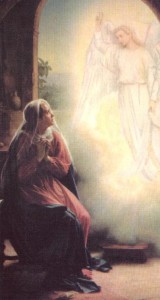 “As a sheaf of grain is tied together in the middle and spreads out at either end, so Mary’s life is bound together by her assent†– from the beginning of “The Handmaid of the Lord” by the great 20th century wife, mother, physician and mystic Adrienne von Spyer. It has become my absolute favorite book on the Blessed Virgin Mary. It has transformed my understanding and deepened my love and appreciation for Mary, the Mother of God…Our Blessed Mother.
“As a sheaf of grain is tied together in the middle and spreads out at either end, so Mary’s life is bound together by her assent†– from the beginning of “The Handmaid of the Lord” by the great 20th century wife, mother, physician and mystic Adrienne von Spyer. It has become my absolute favorite book on the Blessed Virgin Mary. It has transformed my understanding and deepened my love and appreciation for Mary, the Mother of God…Our Blessed Mother.
Mary’s assent to the Lord binds the whole of her life such that “From this assent her life receives its meaning and form and unfolds toward past and futureâ€. This assent, the great “Yes” to the will of God is the moment.
“This single, all-encompassing act accompanies her at every moment of her existence, illuminates every turning point of her life, bestows upon every situation its own particular meaning and in all situations gives May herself the grace of renewed understanding.  Her assent gives full meaning to every breath, every movement, every prayer of the Mother of Godâ€
Everything that we understand Mary to be, do, and say finds her assent at its source.  But, the assent must be understood as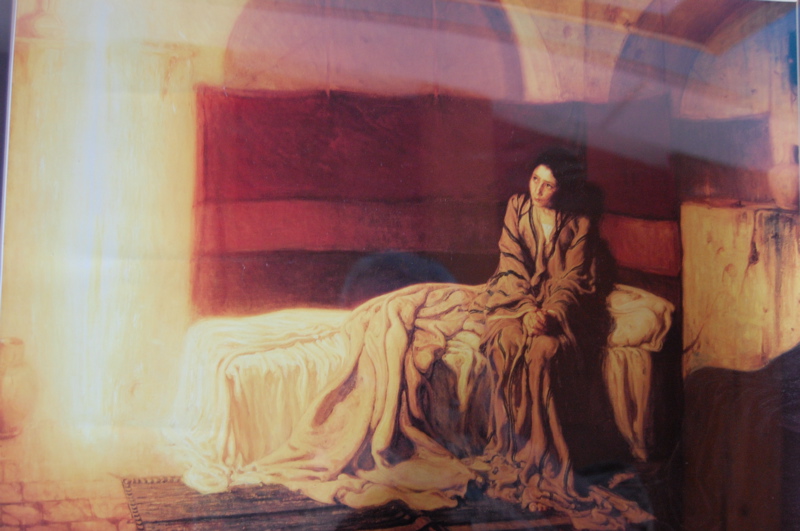 one of freedom, “This is the nature of an assent: it binds the one who gives it, yet it allows him complete freedom in shaping its expressionâ€.  Her assent binds her to the Lord, yet it frees her to express herself dramatically much like the sheaf is bound by the cord around its middle but the sheaf bursts freely outward from the binding cord.
one of freedom, “This is the nature of an assent: it binds the one who gives it, yet it allows him complete freedom in shaping its expressionâ€.  Her assent binds her to the Lord, yet it frees her to express herself dramatically much like the sheaf is bound by the cord around its middle but the sheaf bursts freely outward from the binding cord.
“Mary’s meeting with the angel is like the summation of her entire preceding life of contemplation. It is the first thing we learn about her. We do not know who she is, we do not know her past. But when we learn that she saw the angel, the whole composition of her soul becomes visible. The angel which appears is the fulfillment of her prayer – not in the sense that she had prayed for the appearance or prepared herself for it, but rather in the sense that she has held herself in readiness for a mission still unknown to her. She has lived in an attitude of prayer, and in virtue of this life she is capable in the crucial moment of seeing and obeying the angel who comes to her. Both vision and obedience flow from the same source in her; from the openness toward the mission which God may give her, when and in whatever way he likes. Her obedience is the prototype of every future instance of Christian obedience, which draws its whole meaning from the life of prayer and the perception of God’s will.†[Adrienne von Speyr: Handmaid of the Lord. From the Chapter, “Mary and the Angel“, pg. 27]
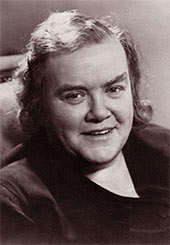 Take a look at an excerpt from “Handmaid of the Lord” you can purchase it from Igantius Press as a book or you may like to download the mp3 reading. Check it out….
Take a look at an excerpt from “Handmaid of the Lord” you can purchase it from Igantius Press as a book or you may like to download the mp3 reading. Check it out….
Tags: adreinne von spyer, adrienne von speyr, angel, assent, blessed virgin mary, catholic, catholic podcast, catholic prayer, cathollc spirituality, handmaid of the lord, mary the mother of god, mission, prayer
This entry was posted on Sunday, March 25th, 2012 at 3:53 am
You can follow any responses to this entry through the RSS 2.0 feed.
The Angel of the Lord declared to Mary: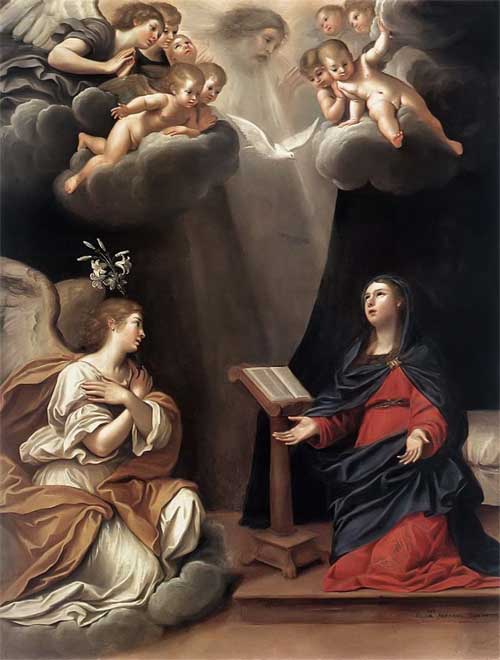
Hail Mary, full of grace, the Lord is with thee; blessed art thou among women and blessed is the fruit of thy womb, Jesus. Holy Mary, Mother of God, pray for us sinners, now and at the hour of
our death. Amen.
Behold the handmaid of the Lord: Be it done unto me according to Thy word.
And the Word was made Flesh: And dwelt among us. Hail Mary . . .
Hail Mary . . .
Pray for us, O Holy Mother of God, that we may be made worthy of the promises of Christ.
Let us pray:
Pour forth, we beseech Thee, O Lord, Thy grace into our hearts; that we, to whom the incarnation of Christ, Thy Son, was made known by the message of an angel, may by His Passion and Cross be brought to the glory of His Resurrection, through the same Christ Our Lord.
Amen.
“Hail, full of grace, the Lord is with you” (Lk 1:28)
“Blessed are you among women,
and blessed is the fruit of your womb”
(Lk 1:42).
Tags: catholic, catholic podcast, catholic prayer, cathollc spirituality, full of grace, hail mary, Holy Mary, mother of god, sacred music, the angelus, Thy Son, women
This entry was posted on Sunday, March 25th, 2012 at 3:52 am
You can follow any responses to this entry through the RSS 2.0 feed.
[powerpress]
O glorious Saint Joseph,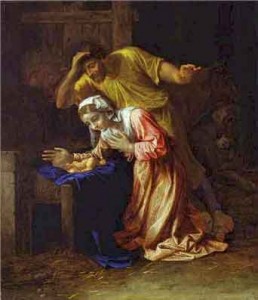
faithful follower of Jesus Christ,
to you we raise our hearts and hands
to implore your powerful intercession
in obtaining from the benign heart of Jesus
all the helps and graces necessary
for our spiritual and temporal welfare,
particularly for the grace of a happy death
and the special favor we now request…
(State your request here.)
O guardian of the Word Incarnate,
we feel animated with confidence that your prayers
in our behalf will be graciously heard before the throne of God.
O glorious St. Joseph,
through the love you bear to Jesus Christ
and for the glory of His name,
hear our prayers
and obtain our petitions.
Amen.
DAY ONE
O great St. Joseph,
with feelings of unlimited confidence,
we beg you to bless this novena that we begin in your honor.
“You are never invoked in vain” says the seraphic St. Theresa of Jesus.
Be you then to me
what you have been to that spouse of the Sacred Heart of Jesus
and graciously hear me as you did her.
Amen.
Saint Joseph, pray for us!
Tags: catholic, catholic podcast, catholic prayer, cathollc spirituality, glorious Saint Joseph, jesus christ, Saint Joseph, st joseph
This entry was posted on Saturday, March 10th, 2012 at 12:03 am
You can follow any responses to this entry through the RSS 2.0 feed.
The little brother in a family of saints, St. Gregory of Nyssa, would be remembered as “the thinker”.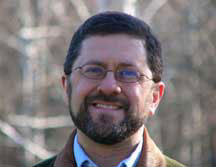 Mike Aquilina shares with us his story,  his role as one of the Cappadocian fathers, and so much more.
Mike Aquilina shares with us his story,  his role as one of the Cappadocian fathers, and so much more.
[powerpress]
Saint Peter’s Square
Wednesday, 29 August 2007Saint Gregory of Nyssa (1)
Dear Brothers and Sisters,
In the last Catecheses, I spoke of two great fourth-century Doctors of the Church, Basil and Gregory Nazianzus, a Bishop in Cappadocia, in present-day Turkey. Today, we are adding a third, St Gregory of Nyssa, Basil’s brother, who showed himself to be a man disposed to meditation with a great capacity for reflection and a lively intelligence open to the culture of his time. He has thus proved to be an original and profound thinker in the history of Christianity.
He was born in about 335 A.D. His Christian education was supervised with special care by his brother Basil – whom he called “father and teacher” (Ep. 13, 4: SC 363, 198) – and by his sister Macrina. He completed his studies, appreciating in particular philosophy and rhetoric.
Initially, he devoted himself to teaching and was married. Later, like his brother and sister, he too dedicated himself entirely to the ascetic life.
He was subsequently elected Bishop of Nyssa and showed himself to be a zealous Pastor, thereby earning the community’s esteem.
When he was accused of embezzlement by heretical adversaries, he was obliged for a brief period to abandon his episcopal see but later returned to it triumphant (cf. Ep. 6: SC 363, 164-170) and continued to be involved in the fight to defend the true faith.
Especially after Basil’s death, by more or less gathering his spiritual legacy, Gregory cooperated in the triumph of orthodoxy. He took part in various Synods; he attempted to settle disputes between Churches; he had an active part in the reorganization of the Church and, as a “pillar of orthodoxy”, played a leading role at the Council of Constantinople in 381, which defined the divinity of the Holy Spirit. (more…)
Tags: catholic, catholic podcast, catholic prayer, cathollc spirituality
This entry was posted on Friday, March 9th, 2012 at 10:41 am
You can follow any responses to this entry through the RSS 2.0 feed.
What is Marian Consecration?  What is the role the Blessed Virgin Mary in our lives?  How can this bring us even more fully into the heart 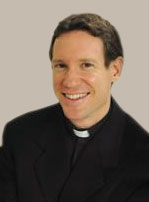 of Divine Mercy? What a joy to talk with Fr. Michael Gaitley, who serves as director of the Association of Marian Helpers, about  “33 Days to Morning Glory: A Do-It-Yourself Retreat in Preparation for Marian Consecration”.  He answers the above the questions above and so much more.
of Divine Mercy? What a joy to talk with Fr. Michael Gaitley, who serves as director of the Association of Marian Helpers, about  “33 Days to Morning Glory: A Do-It-Yourself Retreat in Preparation for Marian Consecration”.  He answers the above the questions above and so much more.
[powerpress]
The goal of the retreat contained in the book is to learn how to ponder more deeply in our hearts what it means to enter into Marian consecration.  With the help of not only St. Louis de Montfort, but also St. Maximilian Kolbe, Bl. John Paul II, and Bl. Mother Teresa of Calcutta, Fr. Gaitley reveals to us the great connection between the heart of Mary and beautiful depth of Divine  Mercy…and the key to it all is…TRUST.
Mercy…and the key to it all is…TRUST.
Find the book here
To learn more about the “All Hearts A Fire” parish programs that Fr. Michael spoke of  click here
Tags: Association of Marian Helpers, catholic, catholic podcast, catholic prayer, cathollc spirituality, marian consecration, Michael Gaitley
This entry was posted on Friday, February 24th, 2012 at 12:16 am
You can follow any responses to this entry through the RSS 2.0 feed.
Saint Peter Damian
from Vatican.va
Dear Brothers and Sisters,
During the Catecheses of these Wednesdays I am commenting on several important people in the life of the Church from her origins. Today I would like to reflect on one of the most significant figures of the 11th century, St Peter Damian, a monk, a lover of solitude and at the same time a fearless man of the Church, committed personally to the task of reform, initiated by the Popes of the time. He was born in Ravenna in 1007, into a noble family but in straitened circumstances. He was left an orphan and his childhood was not exempt from hardships and suffering, although his sister Roselinda tried to be a mother to him and his elder brother, Damian, adopted him as his son. For this very reason he was to be called Piero di Damiano, Pier Damiani [Peter of Damian, Peter Damian]. He was educated first at Faenza and then at Parma where, already at the age of 25, we find him involved in teaching. As well as a good grounding in the field of law, he acquired a refined expertise in the art of writing the ars scribendi and, thanks to his knowledge of the great Latin classics, became “one of the most accomplished Latinists of his time, one of the greatest writers of medieval Latin”
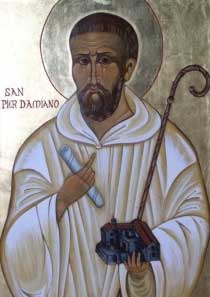 He distinguished himself in the widest range of literary forms: from letters to sermons, from hagiographies to prayers, from poems to epigrams. His sensitivity to beauty led him to poetic contemplation of the world. Peter Damian conceived of the universe as a never-ending “parable” and a sequence of symbols on which to base the interpretation of inner life and divine and supra-natural reality. In this perspective, in about the year 1034, contemplation of the absolute of God impelled him gradually to detach himself from the world and from its transient realties and to withdraw to the Monastery of Fonte Avellana. It had been founded only a few decades earlier but was already celebrated for its austerity. For the monks’ edification he wrote the Life of the Founder, St Romuald of Ravenna, and at the same time strove to deepen their spirituality, expounding on his ideal of eremitic monasticism.
He distinguished himself in the widest range of literary forms: from letters to sermons, from hagiographies to prayers, from poems to epigrams. His sensitivity to beauty led him to poetic contemplation of the world. Peter Damian conceived of the universe as a never-ending “parable” and a sequence of symbols on which to base the interpretation of inner life and divine and supra-natural reality. In this perspective, in about the year 1034, contemplation of the absolute of God impelled him gradually to detach himself from the world and from its transient realties and to withdraw to the Monastery of Fonte Avellana. It had been founded only a few decades earlier but was already celebrated for its austerity. For the monks’ edification he wrote the Life of the Founder, St Romuald of Ravenna, and at the same time strove to deepen their spirituality, expounding on his ideal of eremitic monasticism.
One detail should be immediately emphasized: the Hermitage at Fonte Avellana was dedicated to the Holy Cross and the Cross was the Christian mystery that was to fascinate Peter Damian more than all the others. “Those who do not love the Cross of Christ do not love Christ”, he said (Sermo XVIII, 11, p. 117); and he described himself as “Petrus crucis Christi servorum famulus Peter, servant of the servants of the Cross of Christ” (Ep, 9, 1). Peter Damian addressed the most beautiful prayers to the Cross in which he reveals a vision of this mystery which has cosmic dimensions for it embraces the entire history of salvation: “O Blessed Cross”, he exclaimed, “You are venerated, preached and honoured by the faith of the Patriarchs, the predictions of the Prophets, the senate that judges the Apostles, the victorious army of Martyrs and the throngs of all the Saints” (Sermo XLVII, 14, p. 304). Dear Brothers and Sisters, may the example of St Peter Damian spur us too always to look to the Cross as to the supreme act God’s love for humankind of God, who has given us salvation.
This great monk compiled a Rule for eremitical life in which he heavily stressed the “rigour of the hermit”: in the silence of the cloister the monk is called to spend a life of prayer, by day and by night, with prolonged and strict fasting; he must put into practice generous brotherly charity in ever prompt and willing obedience to the prior. In study and in the daily meditation of Sacred Scripture, Peter Damian discovered the mystical meaning of the word of God, finding in it nourishment for his spiritual life. In this regard he described the hermit’s cell as the “parlour in which God converses with men”. For him, living as a hermit was the peak of Christian existence, “the loftiest of the states of life” because the monk, now free from the bonds of worldly life and of his own self, receives “a dowry from the Holy Spirit and his happy soul is united with its heavenly Spouse” (Ep 18, 17; cf. Ep 28, 43 ff.). This is important for us today too, even though we are not monks: to know how to make silence within us to listen to God’s voice, to seek, as it were, a “parlour” in which God speaks with us: learning the word of God in prayer and in meditation is the path to life.
Tags: catholic, catholic podcast, catholic prayer, cathollc spirituality, doctor of the church, hermit, Peter Damian, Pier Damiani, saint peter damian
This entry was posted on Tuesday, February 21st, 2012 at 12:05 am
You can follow any responses to this entry through the RSS 2.0 feed.
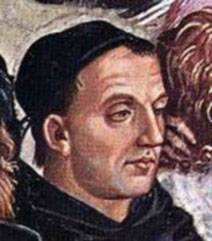 Pope John Paul IIÂ beatified Fra Angelico on October 3, 1982 and in 1984 declared him patron of Catholic artists.
Pope John Paul IIÂ beatified Fra Angelico on October 3, 1982 and in 1984 declared him patron of Catholic artists.
Angelico was reported to say “He who does Christ’s work must stay with Christ always”. This motto earned him the epithet “Blessed Angelico”, because of the perfect integrity of his life and the almost divine beauty of the images he painted, to a superlative extent those of the Blessed Virgin Mary.—Pope John Paul II
Fra Angelico (c. 1395 – February 18, 1455), born Guido di Pietro, was an Early Italian Renaissance painter described by Vasari in his Lives of the Artists as having “a rare and perfect talent”.   He was known to his contemporaries as Fra Giovanni da Fiesole (Brother John from Fiesole) and by Vasari as Fra Giovanni Angelico (Brother John the Angelic One).
Fra Angelico is known in Italy as il Beato Angelico, the term “Il Beato” (“Blessed One”) being already in use during his lifetime or shortly thereafter, in reference to his skills in painting religious subjects. Fiesole is sometimes misinterpreted as being part of his formal name, but it was merely the name of the town where he took his vows as a Dominican friar, and was used by contemporaries to separate him from other Fra Giovannis. He is listed in the Roman Martyrology as Beatus Ioannes Faesulanus, cognomento Angelicus—”Blessed Giovanni of Fiesole, nicknamed Angelico”.
Vasari wrote of Fra Angelico:
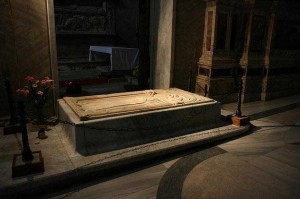
Fra Angelico, Patron Saint of Artists, is buried in the medieval church Santa Maria sopra Minerva, in Rome
But it is impossible to bestow too much praise on this holy father, who was so humble and modest in all that he did and said and whose pictures were painted with such facility and piety.
Tags: catholic, catholic podcast, catholic prayer, cathollc spirituality, sacred art
This entry was posted on Saturday, February 18th, 2012 at 8:37 am
You can follow any responses to this entry through the RSS 2.0 feed.
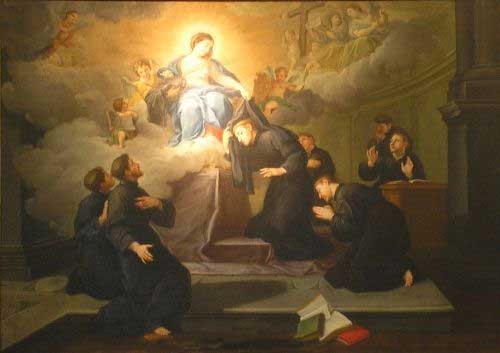
Today is the Church remembers the Seven Founders of the Order of Servites from the 13th Century.
In the mid-13th Century, morals were low and religion seemed nearly meaningless in the political city of Florence. In 1223, seven men from that city decided to form into a small group and go off to a silent place to serve God direct. The Order was founded that day on the Feast of the Assumption as Mary appeared to the seven men. Two of them were widowers and two were still married and brought their families to live together in faith.
They meant to live in solitude, but the group was continually disturbed by visitors. They all left Florence and went to Monte Senario. In 1244, under the direction of St. Peter of Verona, O.P., this group adopted a religious habit similar to the Dominicans and chose to live in accord with the Rule of St. Augustine. They adopted the name of the Servants of Mary.
The men were beatified on December 1, 1717 and canonized in 1887. The original founders were the following:
Saint Alexis Falconieri
Saint Bartholomew degli Amidei
Saint Benedict dell’Antella
Saint Buonfiglio Monaldi
Saint Gherardino Sostegni
Saint Hugh dei Lippi-Uguccioni
Saint John Buonagiunta Monetti
Tags: catholic, catholic podcast, catholic prayer, cathollc spirituality, order of servites, servants of mary, servites
This entry was posted on Friday, February 17th, 2012 at 12:14 am
You can follow any responses to this entry through the RSS 2.0 feed.
Vatican News Service – CLAUDE LA COLOMBIÈRE, third child of the notary Bertrand La Colombière and Margaret Coindat, was born on 2nd February 1641 at St. Symphorien d’Ozon in the Dauphine, southeastern France. After the family moved to Vienne Claude began his early education there, completing his studies in rhetoric and philosophy in Lyon.
It was during this period that Claude first sensed his vocation to the religious life in the Society of Jesus. We know nothing of the motives which led to this decision. We do know, however, from one of his early notations, that he “had a terrible aversion for the life embraced”. This affirmation is not hard to understand by any who are familiar with the life of Claude, for he was very close to his family and friends and much inclined to the arts and literature and an active social life. On the other hand, he was not a person to be led primarily by his sentiments.
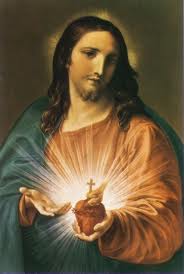 Claude became noted for solid and serious sermons. They were ably directed at specific audiences and, faithful to their inspiration from the gospel, communicated to his listeners serenity and confidence in God. His published sermons produced and still produce significant spiritual fruits. Given the place and the short duration of his ministry, his sermons are surprisingly fresh in comparison with those of better-known orators.
Claude became noted for solid and serious sermons. They were ably directed at specific audiences and, faithful to their inspiration from the gospel, communicated to his listeners serenity and confidence in God. His published sermons produced and still produce significant spiritual fruits. Given the place and the short duration of his ministry, his sermons are surprisingly fresh in comparison with those of better-known orators.
On 2nd February 1675 he pronounced his solemn profession and was named rector of the College at Paray-le-Monial. Not a few people wondered at this assignment of a talented young Jesuit to such an out-of the-way place as Paray. The explanation seems to be in the superiors’ knowledge that there was in Paray an unpretentious religious of the Monastery of the Visitation, Margaret Mary Alacoque, to whom the Lord was revealing the treasures of his Heart, but who was overcome by anguish and uncertainty. She was waiting for the Lord to fulfill his promise and send her “my faithful servant and perfect friend” to help her realize the mission for which he had destined her: that of revealing to the world the unfathomable riches of his love.
After Father Colombière’s arrival and her first conversations with him, Margaret Mary opened her spirit to him and told him of the many communications she believed she had received from the Lord. He 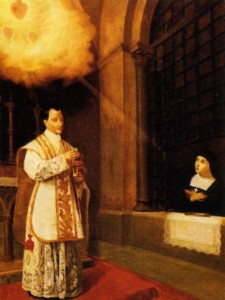 assured her he accepted their authenticity and urged her to put in writing everything in their regard, and did all he could to orient and support her in carrying out the mission received. When, thanks to prayer and discernment, he became convinced that Christ wanted the spread of the devotion to his Heart, it is clear from Claude’s spiritual notes that he pledged himself to this cause without reserve. In these notes it is also clear that, even before he became Margaret Mary’s confessor, Claude’s fidelity to the directives of St. Ignatius in the Exercises had brought him to the contemplation of the Heart of Christ as symbol of his love.
assured her he accepted their authenticity and urged her to put in writing everything in their regard, and did all he could to orient and support her in carrying out the mission received. When, thanks to prayer and discernment, he became convinced that Christ wanted the spread of the devotion to his Heart, it is clear from Claude’s spiritual notes that he pledged himself to this cause without reserve. In these notes it is also clear that, even before he became Margaret Mary’s confessor, Claude’s fidelity to the directives of St. Ignatius in the Exercises had brought him to the contemplation of the Heart of Christ as symbol of his love.
After a year and half in Paray, in 1676 Father La Colombi̬re left for London. He had been appointed preacher to the Duchess of York Рa very difficult and delicate assignment because of the conditions prevailing in England at the time. He took up residence in St. James Palace in October.
In addition to sermons in the palace chapel and unremitting spiritual direction both oral and written, Claude dedicated his time to giving thorough instruction to the many who sought reconciliation with the Church they had abandoned. And even if there were great dangers, he had the consolation of seeing many reconciled to it, so that after a year he said: “I could write a book about the mercy of God I’ve seen Him exercise since I arrived here!”
The intense pace of his work and the poor climate combined to undermine his health, and evidence of a serious pulmonary disease began to appear. Claude, however, made no changes in his work or life style.
Of a sudden, at the end of 1678, he was calumniously accused and arrested in connection with the Titus Oates “papist plot”. After two days he was transferred to the severe King’s Bench Prison where he remained for three weeks in extremely poor conditions until his expulsion from England by royal decree. This suffering further weakened Claude’s health which, with ups and downs, deteriorated rapidly on his return to France.
During the summer of 1681 he returned to Paray, in very poor condition. On 15th February 1682, the first Sunday of Lent, towards evening Claude suffered the severe hemorrhage which ended his life.
On the 16th of June 1929 Pope Pius XI beatified Claude La Colombière, whose charism, according to St. Margaret Mary Alacoque, was that of bringing souls to God along the gospel way of love and mercy which Christ revealed to us.
Tags: catholic, catholic podcast, catholic prayer, cathollc spirituality, margaret mary alacoque, sacred heart of jesus, society of jesus, vatican news service
This entry was posted on Wednesday, February 15th, 2012 at 12:26 am
You can follow any responses to this entry through the RSS 2.0 feed.
Litany of Saint Scholastica
Origin of this litany unknown, but in all details it follows the constant practice and pattern of Medieval litanies; this translation is from St. Benedict’s Manual (1875, 1879, Frederick Pustet). Note the invocation “prevented by the grace of Christ Our Lord,” a now archaic use of “prevented” but which once meant to be helped or succored.
Lord have mercy on us. Lord have mercy on us. Christ have mercy on us. Christ have mercy on us. Lord have mercy on us. Lord have mercy on us. Christ hear us. Christ graciously hear us.
God the Father of Heaven, Have mercy on us. God the Son, Redeemer of the world, Have mercy on us. God the Holy Ghost, Have mercy on us. Holy Trinity, one God, Have mercy on us.
Holy Mary, Pray for us. Holy Mother of God, Pray for us. Holy Virgin of virgins, Pray for us. Saint Scholastica, Pray for us. St. Scholastica, true sister of St. Benedict, Pray for us. St. Scholastica, chosen by God from eternity, Pray for us. St. Scholastica, prevented by the grace of Christ Our Lord, Pray for us. St. Scholastica, consecrated to God from thy infancy, Pray for us. St. Scholastica, always a virgin incorrupt, Pray for us. St. Scholastica, espoused to Jesus Christ, Pray for us. St. Scholastica, scholar of the Holy Ghost, Pray for us. St. Scholastica, mirror of innocence, Pray for us. St. Scholastica, model of perfection, Pray for us. St. Scholastica, pattern of virtues, Pray for us. St. Scholastica, glory of the monastic life, Pray for us. St. Scholastica, mother of numberless virgins, Pray for us. St. Scholastica, imitator of the angelic life, Pray for us. St. Scholastica, full of faith in God, Pray for us. St. Scholastica, replenished with hope of the goods of heaven, Pray for us. St. Scholastica, ever burning with the love of thy Spouse, Pray for us. St. Scholastica, resplendent with humility, Pray for us. St. Scholastica, trusting as a daughter in the Lord, Pray for us. St. Scholastica, intent on prayer, Pray for us. St. Scholastica, quickly heard by the Lord, Pray for us. St. Scholastica, famed for the praise of perseverance, Pray for us. St. Scholastica, who didst enter the courts of Heaven in the form of a dove, Pray for us. St. Scholastica, who dost now follow the Lamb whithersoever He goeth, Pray for us. St. Scholastica, who dost rejoice in delights of thy Spouse for ever, Pray for us. St. Scholastica, adorned with a crown of glory, Pray for us. St. Scholastica, advocate with God of those who invoke thee, Pray for us. St. Scholastica, generous patron of those who imitate thee, Pray for us. St. Scholastica, holy and innocent virgin, Pray for us.
We sinners: Beseech thee, Saint Scholastica, to hear us.
That thou deign to help us, by thy most holy and efficacious prayers to God, We beseech thee, hear us. That thou deign to cherish and preserve, by thy protection, the Benedictine Order (and this monastery) and all who dwell therein, We beseech thee, hear us. (That thou admit us into the number of thy children,) We beseech thee, hear us. That thou deign to raise up, increase, and preserve our devotion toward thee, We beseech thee, hear us. (That thou deign to preserve in us the perfect observance of the Rule of thy blessed brother, our most holy Father Saint Benedict,) We beseech thee, hear us. That thou deign by thy supplications, to moisten the dryness of our hearts with the dew of heavenly grace, We beseech thee, hear us. That, by thy intercession, thou mayest eternally unite us to Christ, the Spouse of our souls, We beseech thee, hear us. That thou mayest lead us to eternal joys, and to Jesus, (our most sweet Spouse), We beseech thee, hear us. That thou wouldst vouchsafe to hear us, We beseech thee, hear us.
Lamb of God, Who takest away the sins of the world: Spare us, O Lord. Lamb of God, Who takest away the sins of the world: Graciously hear its, O Lord. Lamb of God, Who takest away the sins of the world: Have mercy on us.
V. Pray for us, O holy Virgin Scholastica: R. That we may be made worthy of the promises of Christ.
Let us pray. O God, Who, to show the innocence of her life, didst cause the soul of Thy blessed Virgin Scholastica to ascend to Heaven in the form of a dove: grant, we beseech Thee, by her merits and prayers, that we may live so innocently, as to deserve to arrive at eternal joys. Through Jesus Christ, Thine only-begotten Son, Our Lord, Who with Thee and the Holy Ghost liveth and reigneth, God, for ever and ever. R. Amen.
Prayer Source: Kyrie Eleison — Two Hundred Litanies by Benjamin Francis Musser O.F.M., The Magnificat Press, 1944
Tags: catholic, catholic podcast, catholic prayer, cathollc spirituality, Saint Scholastica, st scholastica
This entry was posted on Friday, February 10th, 2012 at 12:39 am
You can follow any responses to this entry through the RSS 2.0 feed.

